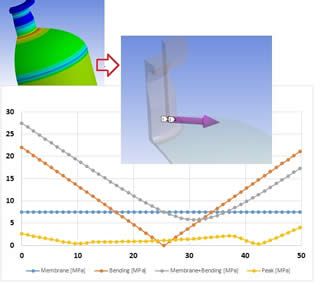Stress linearization is a technique used to decompose a through-thickness elastic stress field into equivalent membrane, bending, and peak stresses for comparison with appropriate allowable limits. Adhering to ASME Boiler & Pressure Vessel Code (BPVC) regulation is crucial for engineers in the industry.
Stress linearization was developed in the pressure vessel industry by Kroenke and Gordon in the 1970s. It was first implemented in Section III (nuclear vessels) and Section VIII, Division 2 (commercial vessels) of the ASME Boiler and Pressure Code. Although widely used in industry thereafter, specific guidance was not included in ASME Boiler & Pressure Vessel Code (BPVC) Section VIII Div. 2 until 2007.
While Ansys Workbench can be used to validate designs, care must be taken in how the stresses and their locations are handled.
To learn about this topic, view our free, one-hour webinar recording that discusses stress linearization and how to use Ansys Workbench to model and validate your designs compatible with ASME BPVC.
Note that you cannot use Internet Explorer (IE) browser to view webinar recordings.
Besides the webinar recording, there is a helpful ACT (Ansys Customization Toolkit) app – Pressure Vessels Automatic Path Creation – available on the Ansys ACT Store.
Lastly, SimuTech Group has several engineers who are well-versed in ASME BPVC. If you are having issues in this area, please contact us to discuss how we can help.
The ASME Boiler & Pressure Vessel Code (BPVC) is an American Society of Mechanical Engineers (ASME) standard that regulates the design and construction of engineering projects across the country




The latest Ansys Software releases to support with force on a construction geometry surface
Ansys Mechanical Workbench is a top-tier finite element solver with capabilities to enhance your modeling in the areas of structural, thermal, acoustical, transient, and nonlinear behavior.
Ansys LS-DYNA simulates the response of materials to short duration severe loading. Today, it is the single most used explicit dynamics simulation program worldwide. Best suited for highly technical users.
Ansys EnSight is the market leader for data visualization. Its post-processing tool includes models with more than hundreds of millions of cells, providing engineers with insights unavailable elsewhere.
Ansys Motor-CAD is a specialized electric machine design tool that allows for quick multiphysics simulation over the entire torque-speed working range.
Ansys HFSS simulates 3-Dimensional full-wave electromagnetic fields for accurate and rapid design of high-frequency and high-speed electronic components.
Gain quick, accurate electronic hardware life predictions with Ansys Sherlock, the only PoF (Reliability Physics/Physics of Failure) software that provides insight at each the system, board, and component levels.
A comprehensive solution for designers, engineers, and analysts that spans the full workflow, from design for additive manufacturing (DfAM) to validation, process simulation, and material exploration
Component-level and system-level simulations are provided by the extensive range of photonics simulation to improve performance, lower the price of physical prototyping, and shorten time-to-market.
Ansys Icepak provides specialized electronic cooling solutions that utilize the industry leading CFD solver for T&F flow analyses of integrated circuits, PCBs and electronics.